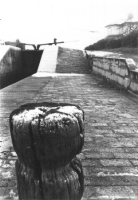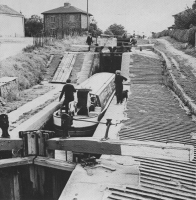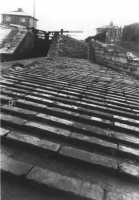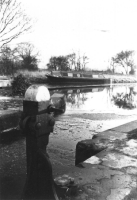Started in 1793 and completed in 1805 the Ellesmere
Canal now known as the Llangollen Canal has a fascinating historyIn
the 1790's two separate
schemes were put forward to link the great rivers Dee near Chester
and the Severn at Shrewsbury. The one to receive an act of parliament
in 1793 was a line from Ellesmere Port in the north through Wrexham,
Trevor, Chirk and Ellesmere then to Shrewsbury linking not only the
Dee and the Severn but the River Mersey as well.
The canal to Whitchurch was just to be one of a number of branch lines
and was to end at Grindley Brook. The main traffic was to be slate,
coal and limestone for fertiliser.
The canal was started with the line across the Wirral and was built
to broad gauge to accommodate the barges of the rivers Mersey and
Dee and the Bridgewater canal. This line was paying its way soon after
opening in 1795.
Cutting had also started in the middle of the line at Chirk and in
1796 a new act of parliament authorised a change of the line from
Chester to Pontcysllte but only 2½ miles near Wrexham were ever built
because new collieries near Chester offered cheaper coal than the
canal could ever supply The owners now looked for a cheaper route
to Chester and decided to extend the Whitchurch branch to Nantwich
and join on to the Shropshire canal.This part of the work was completed
by 1805.
The owners now had a canal very different from the one first proposed.
Though the original main line had now been abandoned the company pressed
on with its massive aqueducts at Chirk and Pontcysllte there being
sufficient business in carrying coal from Ruabon to justify the cost.
It is interesting to speculate as to whether the canal we cruise today
would have survived had the aqueducts not been built. In the 1950's
Tom Rolt forced his narrow boat Cressy up the near derelict canal
and drew attention to its shameful state. That and his help in starting
the IWA ensured that we still have the canal that we now call the
Llangollen. But what if the Pontcysllte aqueduct had not been built,
Telford could have brought his feeder from the Dee down the south
side of the Dee valley as he no longer intended to build a navigation
to Chester. Without the Pontcysllte aqueduct would Tom Rolt have had
the same incentive? |

The old wooden rope worn bollard from the middle chamber (Now sadly
removed)

This view shows the locks in about 1967 when the brick finish was
still in place

A closer view of the brick finish
which prevented horses and men
from slipping

Photographed in about 1978 this view of the top of the staircase lock
shows the old paddle gear still in place.
Rope marks from the wet tow-ropes of horse drawn boats were visible
near the top of the paddle. |



